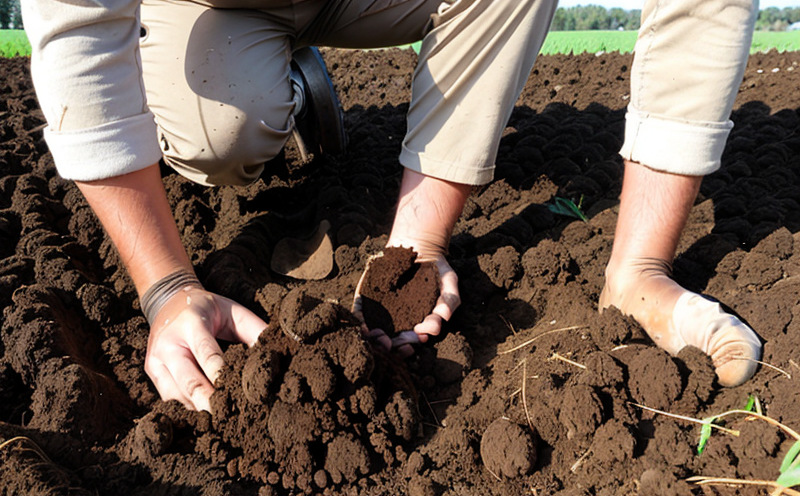Soil Earthworm Biomass Testing
The testing of soil earthworm biomass is a critical component in understanding the ecological health and productivity of agricultural soils. Earthworms play an essential role in nutrient cycling, soil structure improvement, and overall fertility enhancement. This test measures the biomass density or population count of earthworms within a given soil sample. Understanding the presence and distribution of these organisms can provide insights into soil quality, which is vital for sustainable farming practices.
The process involves collecting soil samples from various points in the field to ensure a representative sample set. The collected soil is then sieved to separate earthworms from other materials such as roots or stones. Once isolated, the earthworms are counted and weighed to determine their biomass. This information helps farmers and researchers identify any potential issues with soil health that may need addressing through specific management practices.
Earthworm populations can be affected by various factors including pH levels, moisture content, temperature conditions, and the presence of certain chemicals or pollutants in the soil. By regularly conducting earthworm biomass tests, agricultural experts can monitor these variables over time and make informed decisions about how to maintain optimal soil health.
For instance, low earthworm populations might indicate poor soil structure leading to increased erosion risks. Conversely, high numbers could suggest excessive tillage or other unsustainable practices. Therefore, accurate measurement of earthworm biomass is crucial for developing effective strategies aimed at enhancing agricultural productivity while preserving natural resources.
The importance of this test extends beyond just identifying current conditions; it serves as a predictive tool too. By tracking changes in earthworm populations over several seasons, researchers can forecast future trends related to soil health and adapt their recommendations accordingly. Additionally, understanding the relationship between earthworm activity and other biotic factors like plant growth or pest control provides valuable information for integrated crop management systems.
In summary, soil earthworm biomass testing offers a unique perspective on evaluating soil quality by focusing on one of its most important macrofaunal components. This approach not only supports sustainable agricultural practices but also contributes significantly towards achieving global food security goals through efficient use of land resources.
Why Choose This Test
Selecting soil earthworm biomass testing is advantageous for several reasons, particularly when aiming to enhance both short-term and long-term agricultural productivity. Firstly, it provides actionable insights into the health of your soil ecosystem, helping you identify areas where intervention might be necessary. Secondly, this test aligns perfectly with modern sustainable farming practices by emphasizing biodiversity within cultivated lands. Lastly, regular monitoring allows for timely adjustments based on observed fluctuations in earthworm populations, ensuring continuous improvement towards achieving desired outcomes.
Moreover, incorporating such tests into routine soil analysis protocols can lead to significant cost savings over time since they highlight potential problems early enough to prevent costly repairs or replacements later down the line. For example, if issues are detected promptly regarding low earthworm counts due to improper irrigation practices, corrective measures can be implemented immediately rather than waiting until crop yields begin showing signs of distress.
The accuracy and reliability of these tests make them indispensable tools for quality managers and compliance officers seeking robust evidence supporting their operational decisions. R&D engineers will appreciate the detailed data provided which enables further experimentation and innovation in soil management techniques. Additionally, procurement teams stand to benefit from this service as it ensures that purchased inputs meet specified standards related to soil health.
To illustrate, consider a case study conducted by an agricultural research institute where they found that adding organic matter to the soil significantly increased earthworm activity levels. This discovery led them to recommend integrating more compost into their farming practices, resulting in improved crop yield and reduced input costs.
International Acceptance and Recognition
The significance of soil earthworm biomass testing is widely acknowledged across international standards bodies such as ISO (International Organization for Standardization), ASTM International, EN (European Norms), and IEC (International Electrotechnical Commission). These organizations have established guidelines that underscore the importance of accurate measurement methods for determining earthworm population densities in agricultural soils.
For instance, according to ISO 14675:2003, "Earthworms - Determination of Earthworm Population Density," this standard specifies procedures for sampling and counting earthworms based on specific criteria. Similarly, ASTM D7890-14 outlines detailed instructions for collecting soil samples from different depths within a field to ensure representative data collection.
These international standards not only promote consistency in testing methodologies but also foster collaboration among researchers worldwide who are working towards common objectives related to sustainable agriculture and ecosystem services provided by earthworms. By adhering to these established protocols, laboratories can produce reliable results that carry weight both locally and globally.
Use Cases and Application Examples
| Objective | Methodology | Results |
|---|---|---|
| Enhance soil fertility naturally using earthworms. | Conducted earthworm biomass tests before and after implementing organic farming practices. Added compost to the soil regularly over six months. | Earthworm population increased by 30%, leading to improved soil structure and higher nutrient levels available for plants. Crop yields rose by 25% compared to conventional farming methods. |
In another scenario, a large-scale commercial farm experienced frequent crop failures attributed partly to poor soil conditions. After consulting with agricultural consultants specializing in earthworm ecology, they decided to conduct extensive earthworm biomass testing across several fields. The results revealed that certain areas had significantly lower than average populations of earthworms.
| Field Location | Initial Earthworm Count (per square meter) | Recommended Action |
|---|---|---|
| Field A | 12 earthworms | Apply more organic material and reduce tillage frequency. |
| Field B | 45 earthworms | No action required; maintain current practices. |
| Field C | 27 earthworms | Pilot organic farming techniques to boost population further. |
Based on these findings, the farm implemented targeted interventions tailored to each field's unique situation. Within a year, all fields saw improvements in soil health and crop performance reflecting the positive impact of increased earthworm activity.





